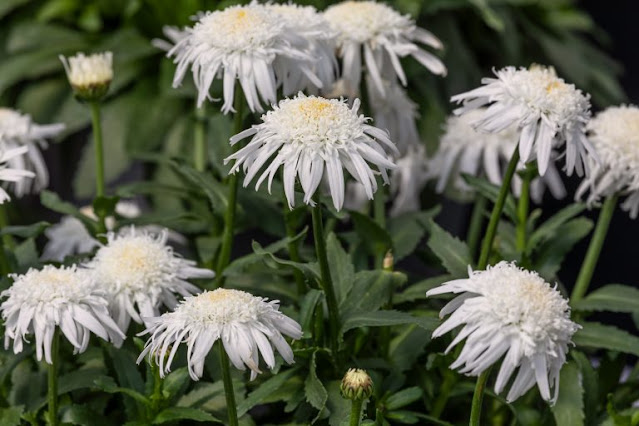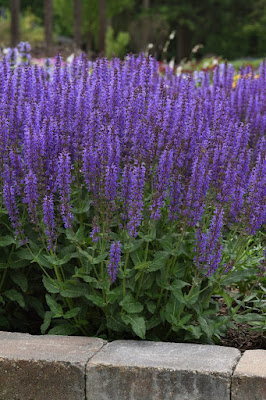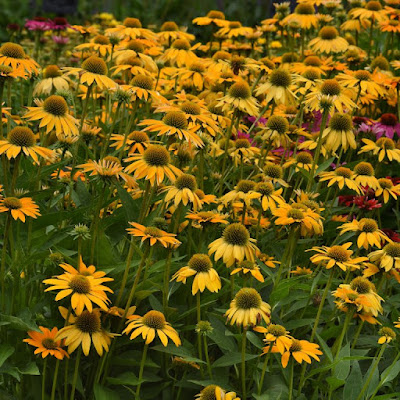
All-America Selection winners include new salvia, coneflower and groundcover Shasta daisy

|
| Carpet Angel is a new groundcover Shasta daisy, among the just-announced 2023 All-America Selections perennial winners. (Photos courtesy All-America Selections) |
Gardeners are always looking ahead. We have to! It takes time to go from seed to bloom or harvest.
So, in the middle of Summer 2022, we’re looking forward to Summer 2023 and the new varieties we’ll see (and grow) next year.
Whetting our appetite for new flowers is the announcement this week of the first 2023 All-America Selections winners. The AAS committee dribbles out its winners list, and the first to be revealed are three perennials that are improvements on old favorites.
National perennial winner is a pretty blue sage that can handle both extreme cold and blast-furnace heat. Blue By You salvia ( https://tinyurl.com/m5bm86cd ), developed by Chicago-based Darwin Perennials, offers six months of bloom with little effort.

|
| Blue By You salvia is a national AAS winner. |
A hybrid between Salvia nemorosa and Salvia pratensis , Blue by You is a bee magnet. It needs average irrigation and grows about 20 to 22 inches tall. Another plus: Deer don’t like it.
Two regional winners also were revealed: A hybrid coneflower and a groundcover Shasta daisy.
Artisan Yellow Ombre echinacea ( https://tinyurl.com/5xyxwy6w ), developed by PanAmerican Seed (which does a lot of plant breeding and testing in Yolo County), is an improved coneflower with strong, straight stems – great for cutting. Named the Southeast and Northwest regional winner, it grows 24 to 30 inches tall and blooms continuously for months.
(Both Darwin Perennials and PanAmerican Seed are part of Ball Horticultural.)
“Artisan Yellow Ombre is a great plant for anyone wanting vibrant color all season long in their perennial garden, or to use as a cut flower,” says the AAS committee.

|
|
Artisan Yellow Ombre coneflower was named a regional winner.
|
Other colors in the Artisan series of coneflowers (so far) include Red Ombre and Soft Orange.
The most unusual All-America Selection winner may be the groundcover Shasta daisy Carpet Angel ( https://tinyurl.com/5n873mun ); it was named the West regional winner. The only AAS winner of its kind, it’s also the first AAS winner for breeder Green Fuse Botanicals of Santa Paula, Calif.
“Green Fuse Botanicals’ First Light Perennials is a program of first-year flowering perennials that are day-length neutral, meaning earlier blooms that continue all season long,” explains the AAS committee. “Large 3-inch flowers boast a second inner frilly bloom adding to the unique look of Carpet Angel.
"Growing only to a height of 6 inches, this unique Leucanthemum can act as a groundcover spreading up to 20 inches wide. Fantastic branching on this new AAS winner means more flower stems sporting beautiful pure white blooms that look like angels dancing over a carpet of dark green foliage. A little deadheading of spent flowers will reward you with even more blooms.”
Look for these plants in nurseries and plant catalogs next spring.
Learn more about All-America Selections and how these plants were tested: https://all-americaselections.org/ .
Comments
0 comments have been posted.Sacramento Digs Gardening to your inbox.
Sites We Like
Garden Checklist for week of July 21
Your garden needs you!
* Keep your vegetable garden watered, mulched and weeded. Water before 8 a.m. to reduce the chance of fungal infection and to conserve moisture.
* Feed vegetable plants bone meal, rock phosphate or other fertilizers high in phosphate to stimulate more blooms and fruiting. (But wait until daily high temperatures drop out of the 100s.)
* Don’t let tomatoes wilt or dry out completely. Give tomatoes a deep watering two to three times a week.
* Harvest vegetables promptly to encourage plants to produce more. Squash especially tends to grow rapidly in hot weather. Keep an eye on zucchini.
* Pinch back chrysanthemums for bushy plants and more flowers in September.
* Remove spent flowers from roses, daylilies and other bloomers as they finish flowering.
* Pinch off blooms from basil so the plant will grow more leaves.
* Cut back lavender after flowering to promote a second bloom.
* It's not too late to add a splash of color. Plant petunias, snapdragons, zinnias and marigolds.
* From seed, plant corn, pumpkins, radishes, winter squash and sunflowers.